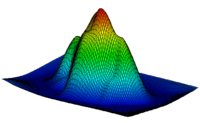|
|
| Line 6: |
Line 6: |
|
| |
|
| ==Grid → TIN== | | ==Grid → TIN== |
| Creates a new TIN from the selected 2D grid. Two triangles are created from each cell in the grid. The TIN ''Properties'' dialog will appear before the conversion is completed allowing the new TIN to be named and assigned a material. | | Creates a new TIN from the selected 2D grid. Two triangles are created from each cell in the grid. The TIN ''Properties'' dialog will appear before the conversion is completed allowing the new TIN to be named, assigned a material, and the TIN data can be reviewed. |
|
| |
|
| ==Grid → 2D Mesh== | | ==Grid → 2D Mesh== |
2D Grids may be converted to other types of data used in GMS, such as a TIN, 2D mesh, or 2D scatter points. 2D Grids can be converted by using the following commands in the Grid menu:
Grid → 2D Scatter Points
Creates a new scatter point set using the nodes or cells of the 2D grid. A copy is made of each of the datasets associated with the grid and the datasets are associated with the new scatter point set. A prompt will ask to name the new scatter set.
Grid → TIN
Creates a new TIN from the selected 2D grid. Two triangles are created from each cell in the grid. The TIN Properties dialog will appear before the conversion is completed allowing the new TIN to be named, assigned a material, and the TIN data can be reviewed.
Grid → 2D Mesh
Creates a new 2D finite element mesh from the 2D grid. A four node quadrilateral element is created from each cell in the grid. A prompt will ask whether to create the mesh using the cell center (centroids) or using the cell corners.
Grid → Ugrid
Creates a new unstructured grid using the 2D grid. The new Ugrid will use the dimension of the 2D Grid.
Contours → Arcs
Creates a new feature coverage containing arcs derived from the linear contours on the 2D grid. The command only works if linear contours are being displayed.
